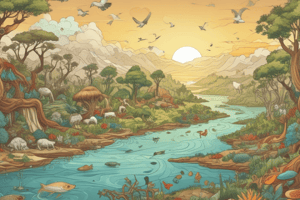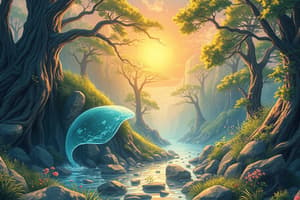Podcast
Questions and Answers
What is a primary objective of biodiversity conservation?
What is a primary objective of biodiversity conservation?
- Promote biodiversity extinction
- Maintain essential ecological processes (correct)
- Reduce genetic diversity
- Increase habitat destruction
Which of the following describes a 'Critically Endangered' species according to IUCN criteria?
Which of the following describes a 'Critically Endangered' species according to IUCN criteria?
- High risk of endangerment in the wild
- Species survive only in captivity
- Population has declined by 50-70% in a decade
- Population declined by 80-90% over the decade (correct)
Which method involves protecting species in their natural habitat?
Which method involves protecting species in their natural habitat?
- Botanical Gardens
- In-Situ Conservation (correct)
- Gene Banks
- Zoological Gardens
What is a consequence of habitat destruction on biodiversity?
What is a consequence of habitat destruction on biodiversity?
Which component of an ecosystem is primarily responsible for producing energy?
Which component of an ecosystem is primarily responsible for producing energy?
Which of the following is NOT a type of extinction according to the provided content?
Which of the following is NOT a type of extinction according to the provided content?
What is a significant consequence of the tragedy of the commons?
What is a significant consequence of the tragedy of the commons?
What is an example of ex-situ conservation?
What is an example of ex-situ conservation?
Which ecosystem is characterized by limited water supply and extreme temperature variations?
Which ecosystem is characterized by limited water supply and extreme temperature variations?
What primarily prevents the growth of smaller plants in tropical rain forests?
What primarily prevents the growth of smaller plants in tropical rain forests?
What aspect of ecosystems does ecological succession primarily refer to?
What aspect of ecosystems does ecological succession primarily refer to?
Which factor is NOT a human-caused stress on biodiversity?
Which factor is NOT a human-caused stress on biodiversity?
Which of the following is NOT a primary focus of environmental education?
Which of the following is NOT a primary focus of environmental education?
Which of the following is considered an abiotic component of an ecosystem?
Which of the following is considered an abiotic component of an ecosystem?
What characterizes a 'Least Concern' species?
What characterizes a 'Least Concern' species?
Which ecological service is associated with ponds?
Which ecological service is associated with ponds?
What is the primary concern associated with global environmental problems?
What is the primary concern associated with global environmental problems?
Which of the following fields contributes to understanding the interdisciplinary nature of environmental studies?
Which of the following fields contributes to understanding the interdisciplinary nature of environmental studies?
What is a primary consumer found in ponds?
What is a primary consumer found in ponds?
Which impact is a consequence of anthropogenic effects on ecosystems?
Which impact is a consequence of anthropogenic effects on ecosystems?
The concept of carrying capacity refers to which of the following?
The concept of carrying capacity refers to which of the following?
Which of the following ecosystems is characterized by grasses and insufficient rainfall for tree growth?
Which of the following ecosystems is characterized by grasses and insufficient rainfall for tree growth?
What describes ecological succession?
What describes ecological succession?
Which of the following is NOT a commercial service provided by ecosystems?
Which of the following is NOT a commercial service provided by ecosystems?
Which type of wetland is characterized by slow-moving streams and rivers, and contains wood shrubs rather than grass?
Which type of wetland is characterized by slow-moving streams and rivers, and contains wood shrubs rather than grass?
What ecological function do wetlands provide that helps in climate change mitigation?
What ecological function do wetlands provide that helps in climate change mitigation?
What is the primary abiotic condition of the taiga ecosystem?
What is the primary abiotic condition of the taiga ecosystem?
Which type of coral reef is formed around islands or parallel to the continental shore with a lagoon separating it from land?
Which type of coral reef is formed around islands or parallel to the continental shore with a lagoon separating it from land?
What is the predominant temperature range for the survival of shallow water corals?
What is the predominant temperature range for the survival of shallow water corals?
Which ecosystem is known for having permafrost and short vegetation with no trees?
Which ecosystem is known for having permafrost and short vegetation with no trees?
What is a characteristic feature of estuaries?
What is a characteristic feature of estuaries?
Which biotic component is typically found in the taiga ecosystem?
Which biotic component is typically found in the taiga ecosystem?
What is the main concept behind community resilience in the context of climate change?
What is the main concept behind community resilience in the context of climate change?
Which of the following correctly defines biodiversity within an ecosystem?
Which of the following correctly defines biodiversity within an ecosystem?
What does homeostasis refer to within an ecological context?
What does homeostasis refer to within an ecological context?
Which of the following statements about limiting factors in ecosystems is true?
Which of the following statements about limiting factors in ecosystems is true?
According to ecological principles, what explains the energy loss along the food chain?
According to ecological principles, what explains the energy loss along the food chain?
In the context of ecosystems, which component is considered biotic?
In the context of ecosystems, which component is considered biotic?
What does the term 'energy cycling' refer to in ecosystems?
What does the term 'energy cycling' refer to in ecosystems?
Which of the following best describes a food chain?
Which of the following best describes a food chain?
Flashcards are hidden until you start studying
Study Notes
Environment and Ecosystems
- The environment encompasses physical, chemical, and biological systems, motivating a multidisciplinary approach to study ecosystems.
- Ecosystems contain both living (biotic) and non-living (abiotic) components that interact to sustain life.
- Structure of ecosystems includes producers (like plants), consumers (herbivores, carnivores), and decomposers (fungi, bacteria).
- Energy flows through ecosystems in a unidirectional manner; only about 10% is passed along trophic levels.
- Ecological succession refers to the sequential changes in community structure until a stable ecosystem forms.
Types of Ecosystems
- Forest Ecosystems: Diverse habitats with trees providing shade and habitat for various species.
- Grassland Ecosystems: Dominated by grasses, they exist in regions with insufficient rainfall for tree growth.
- Desert Ecosystems: Characterized by low rainfall and extreme temperatures, home to specially adapted plants and animals.
- Aquatic Ecosystems: Include various freshwater (ponds, lakes) and marine (oceans, estuaries) environments with rich biodiversity.
Biodiversity and Conservation
- Biodiversity is crucial for ecosystem functioning and resilience; it entails the variety of living beings and their habitats.
- Conservation methods include both in-situ (protecting species in their natural habitats) and ex-situ (preserving species in captivity).
- The International Union for Conservation of Nature (IUCN) maintains categories of species based on their extinction risk, from "Least Concern" to "Extinct."
Ecological Principles
- Homeostasis refers to biological systems' tendency to maintain equilibrium despite changes in the environment.
- Limiting factors (like water, nutrients) play a crucial role in the productivity of ecosystems.
- First law of thermodynamics highlights energy conservation, whereas the second law indicates energy transformation leads to increased entropy.
Food Webs and Chains
- Food chains represent linear energy transfer, while food webs illustrate complex interconnections among different organisms.
- Each ecosystem plays vital roles, such as nutrient retention, climate regulation, and supporting biodiversity.
Threats to Biodiversity
- Major threats include habitat destruction, pollution, climate change, and introduction of invasive species.
- Human activities accelerate species extinction rates, impacting ecosystem stability and resilience.
Extinction Categories
- Extinction categories defined by IUCN include:
- Extinct: No remaining individuals.
- Endangered: High risk of extinction, significant population decline.
- Vulnerable: High risk of endangerment in the wild.
Public Awareness and Policy
- Public engagement is critical for effective climate change adaptation and sustainability practices.
- Communities must be educated on environmental risks and how they can contribute to resilience-building actions.
Ecosystem Services
- Ecosystems provide essential services such as water purification, flood control, and climate regulation.
- Anthropogenic effects include pollution and habitat degradation, necessitating awareness and intervention strategies.
Conservation Strategies
- In-situ methods focus on protecting ecosystems and promoting sustainable resource usage, including protected areas and wildlife corridors.
- Ex-situ methods involve preserving biodiversity through gene banks, botanical gardens, and zoological institutions.
Studying That Suits You
Use AI to generate personalized quizzes and flashcards to suit your learning preferences.




